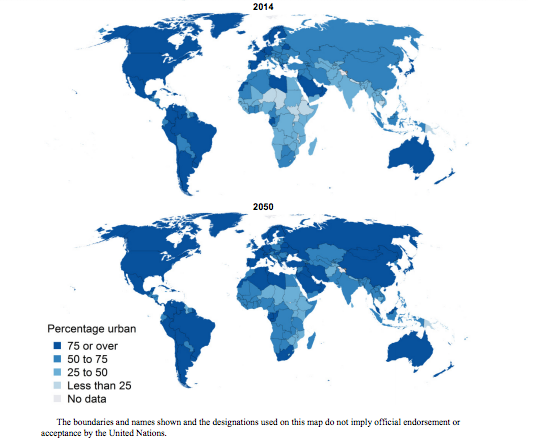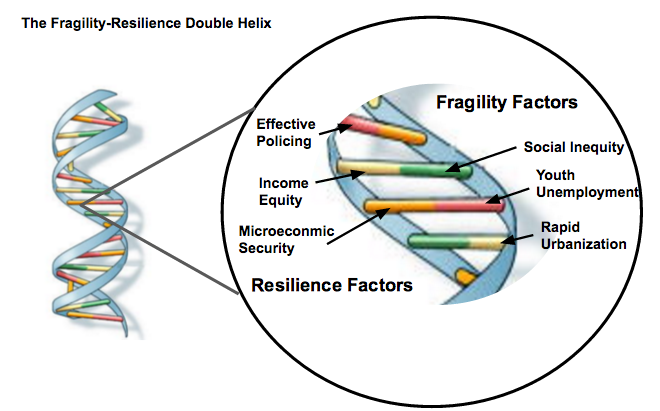This is the first in our series of blog posts on our ongoing work on urban fragility and resilience
“In the 1800s, 1 in 30 people lived in cities; today it is 1 in 2; and tomorrow virtually everyone is going to be there,” Robert Muggah reported in the Ted Radio Hour episode Building Better Cities.1
Over half of the world’s population (54%) lives in urban areas and that number is projected to grow to more than two-thirds (66%) by the year 2050.2 The rate of urban population growth is not only continuing, but its speed is dramatically quickening: urbanization is producing between 65 and 70 million new urban occupants a year.3 For the first time in our history, more people live in cities than outside of them, and the UN estimates that more than 90% of future population growth will occur in cities.4 As the pace of urbanization quickens in our increasingly global and interconnected world, emergencies and disasters will concentrate in cities, rather than nation states. In the face of these shocks and stress, government, institutional, and community capacities to effectively respond, provide services and security, and govern will be tested. These capabilities will be pushed to the brink predominantly in cities not in North America or Western Europe, but rather in Africa, Asia, and Latin America—areas that have the world’s fastest growing cities and are most prone to conflict, disasters and natural hazards.5
Figure 1: Map of urbanization growth from 2014 vs. 20506
Although urbanization is often linked to opportunity and innovation—ushering in new possibilities for health, education, wellbeing, and the exchange of goods and services—urbanization also produces new risks to security and stability. Areas that rapidly urbanize are often prone to high rates of violence, drug trafficking, crime, and unemployment, all of which undermine their governance, economic productivity, and livability. As the challenges due to risk factors to these urban areas increase, there is a real possibility that these cities become disrupted and fragile.
While all cities possess distinctive strengths and weaknesses, some are more successful and resilient than others. But how, why, and when do cities succumb to fragility or endure in resilience? Surprisingly, there is limited information available—i.e. structured (administrative) and unstructured (ambient) data—about the underlying security and stability of cities before, during, and following exposure to stress. This is a critical knowledge and capacity gap that urgently needs attention, as Sustainable Development Goal 11 of the post-2015 UN Development Agenda emphasizes the importance of constructing stable and resilient cities.7 As urbanization develops unevenly and inequitably and at a fast-moving and dynamic speed, understanding resilience and fragility is vital. However, the concepts of fragility and resilience are difficult to define because of the many parameters respective to the communities that construct each unique city and their personal challenges.
“Managing urban areas has become one of the most important development challenges of the 21st century. Our success or failure in building sustainable cities will be a major factor in the success of the post-2015 UN development agenda”
John Wilmoth, Director of UN DESA’s Population Division
In recognizing the complexity of urban environments, we may be better equipped to identify fragility by bringing together many factors to inform modeling. Some work has begun in attempting to better define what it means for a city to be resilient and fragile. Robert Muggah, Ronak Patel, and Joseph de Boer have recently initiated work on mapping a conceptual framework for resilience and fragility in “City fragility and resilience: a preliminary conceptual framework,” a background paper for the UNU/World Bank project on fragile and resilient cities. Fragile cities, as described by Muggah, Patel, and de Boer, are “those that are susceptible to a rapid deterioration and erosion to core functions owing to an overwhelming accumulation of internal and external risks.”8 These risks can take on many forms, including economic, environmental, political, and social. Some empirical evidence has pointed to a few factors that shape urban fragility9:
- Rapid and unregulated urbanization
- Income and social inequality
- Concentrated poverty
- Youth unemployment
- Policing and justice deficits
- Real and perceived insecurity
- Natural hazard exposure
Resilient cities on the other hand, are cities that have the ability to preserve or improve core functions even in the face of stress and shocks. This is done by reducing exposure, limiting vulnerabilities, and enhancing adaptations to stress through institutional, individual, organizational or community action. This ability to preserve core functions is usually determined by a collection of relations between the state and the society. Factors related to shaping city resilience are usually identified as the reverse of those linked to fragility, yet this presents only a basic understanding of the complex and interactive nature of resilience factors. These factors include10:
- Income and social equity
- Effective policing and justice mechanisms
- Microeconomic security/social protection
- Provision of basic services
- Social cohesion
- Social networks/social support
- Strong community-government cooperation
A common misconception surrounding urban fragility and resilience lies in perception that fragility and resilience are mutually exclusive. Additionally, a common assumption is that the relationship between fragility and resilience is inversely related (i.e. reduction of fragility is that same as the promotion of resilience, or vice versa)11; however, this is not necessarily always the case. Urban fragility and resilience can exist acutely and chronically, both at the same time (e.g. San Francisco with pockets of fragility and violence in several neighborhoods and Mogadishu with pockets of resilience among communities of entrepreneurs). Although typically understood as separate and opposing concepts, fragility and resilience are actually interconnected and overlapping phenomena. Additionally, the presence of fragility does not necessarily imply the absence of resilience.12
Muggah, Patel, and de Boer illustrate the connection between resilience and fragility within a city using the fragility-resilience double helix (see Figure 2).13 This relationship helps to define the specific capacities of a city to retain core functions in the face of stress and hazards by delineating the resilient and fragile factors the city holds. The unique identity of each city, or the urban identity, is created by factor variation, just like genetic variation accounts for human individuality. The urban identity defines the city’s ability to respond to internal or external stressors. Nonetheless, it is not just about the type of factors the double helix possesses, but also how those factors interact. The coexistence of both fragility and resilience brings about a new understanding about why, where, and how these varying concepts produce cities that succumb to fragility or endure in resilience. The interactions of these factors pose unique vulnerabilities and strengths to stress in the same way that our genetic make-up creates immunities or susceptibility to diseases in the human body.
Figure 2: The Fragility-Resilience Double Helix14
For example, Celiac disease, a disease caused by the genetic variant of the HLA-DQB1 gene, produces an abnormal vulnerability to gluten in the human body. Without acknowledgment of the disease and a strict adherence to a gluten-free diet, the body becomes irritated and causes a wide variety of symptoms in reaction to gluten. Similarly, Medellin, Colombia in the 1990s held fragility and resilience factors that caused it to be extremely vulnerable to chronic crime, making it one of the most murderous cities in the world. However, over the past few decades, Medellin has incorporated new resilience factors by building cable cars and a metro to connect poor areas to middle class ones; installing quality infrastructure in the poorest areas; and establishing social programs that target some of the most vulnerbale populations – youth – with risk reduction programs. Despite the fragility factors of drug trafficking still present in the city in addition to rapid urbanization of the city, these added resilience factors have shifted Medellin to a new urban identity: much less susceptible to acute outbreaks of conflict and better equipped to handle chronic crime. Since the 1990s, Medellin’s murder rate has dropped by 80%.15 Although DNA and genetic variation may be fixed at conception, urban variation and its fragile and resilient factors may wax and wane over time. While the relationship between fragility and resilience can be described as a double helix, the qualities themselves can still be learned.
Due to the fact that not all cities evolve equally, identifying these factor variants and their relationships within urban helixes could prove extremely useful for the future of urbanization and sustainable development in preventing citywide disturbances and failures. Mapping the extent of fragility and resilience within a city will require an in-depth analysis of the factor variants of a city and the systems and protocols necessary to handle threats. Because of the complexity of cities themselves, identifying connections and interactions between factors will require the amassment of robust data. As the digital divide continues to shrink due in part to urbanization, the use of information and communication technologies as a source for measuring and determining fragility and resilience factors that make up city identity will become valuable.16
The emergence of Big Data is opening avenues for research on city resilience and fragility. The data “crumbs” about human behaviors and beliefs generated and collected by technological devices, the “capacities” of powerful and analytical computations and tools, and the “community” of actors working within the field will all contribute to the empirical understanding of the factors and interactions between fragility and resilience. Big Data could potentially reveal problems and solutions surrounding current and future urban centers. With the knowledge amassed through Big Data’s three C’s, it is possible that we may build better cities able to adapt and maintain equilibrium in the face of political, economic, social, or environmental stresses.
Works cited





